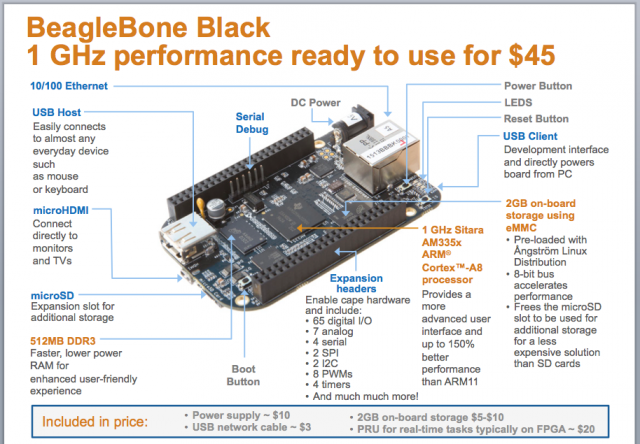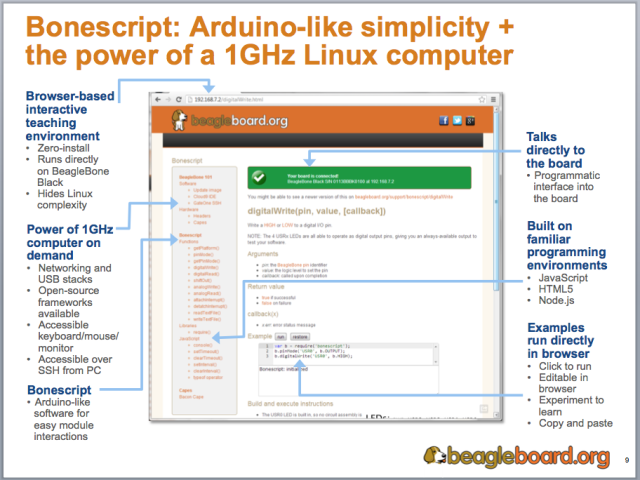
The market for cheap single-board computers is becoming one of the most surprisingly competitive spaces in the tech industry. On the heels of the million-selling Raspberry Pi, a variety of companies and small groups started creating their own tiny computers for programmers and hobbyists.
Today we have a new entrant that may provide the best bang for the buck for many types of users. It's called the BeagleBone Black and it's the latest in the line of "Beagle" devices that first appeared in 2008, courtesy of Texas Instruments. On sale now for $45, BeagleBone Black sports a 1GHz Sitara AM335x ARM Cortex-A8 processor from Texas Instruments, up from the 720MHz processor used in the previous $90 BeagleBone released in 2011. (Edit: While the purchase link is live, the device may not be available until tomorrow morning. It will also be available at BeagleBoard.org/buy.)
Beagle's "open" hardware philosophy means all of the chips and designs are available to the public, so anyone with the right equipment and knowledge could make their own.
Using an ARMv7 processor instead of the Pi's ARMv6 one, BeagleBone can run Ubuntu or other Linux distributions as well as Android. It also provides more inputs and outputs than the Pi for connecting to sensors and other devices needed to build robots and electronics projects. The BeagleBone Black has significantly more inputs and outputs than an Arduino Uno, and similar numbers as the newer Arduino Due.
"This has a lot more I/Os than an Arduino Uno would have," BeagleBoard.org co-founder Jason Kridner told Ars. "It's a full gigaherz Linux desktop computer, but it has all the I/O capabilities you'd have in a typical microcontroller. It really bridges that gap, combining those two worlds together."
Beagle has a thriving development community. There are more than 30 "capes," or plug-in boards compatible with the BeagleBone Black. These allow the device to connect to 3D printers, DMX lighting controllers, a Geiger counter, a telerobotic submarine, LCD touch screens, and more.
Beagle runs semi-independently of Texas Instruments, which sponsors the project with technology and its employees' time. Kridner is a TI employee, but spends nearly all of his time on Beagle projects.
100,000 boards will be made in the first production run of BeagleBone Black. The previous generation sold about 50,000 to 60,000 units "at twice the cost and less performance," Kridner said. He has been amazed by what developers have done with Beagle products so far, and figures it can only get better with the BeagleBone Black.
"You can build 3D printers, you can build rovers, you can build drones, you can build art projects, street lighting," Kridner said. Beagle users are "doing software-defined radio, inspecting the spectrum and wardriving, and searching for faults in the wireless communications systems. I cannot possibly keep up with what everybody's doing with this board."
The processing power and price aren't the only reasons Kridner thinks BeagleBone Black will inspire even greater heights of hacking. The board will be more user-friendly than the previous version, with a MicroHDMI hookup, a pre-installed Linux distribution, and an upgraded Web interface for controlling Arduino-like functionality.
Here's an at-a-glance look at the BeagleBone Black's specs (click for a larger view):

Although BeagleBone Black costs $10 more than a Raspberry Pi, it comes with a power supply and network cable whereas the Pi does not. (UPDATE: the people behind BeagleBone told us the product would come with a power supply, it turns out the actual shipments do not include one.) BeagleBone Black has 2GB of on-board storage that's pre-installed with Ångström Linux, and the MicroSD slot can be used for additional storage or to boot another operating system. BeagleBone Black upgrades the RAM over the previous version from 256MB of DDR2 memory to 512MB of DDR3L memory.
A MicroHDMI slot allows direct connections to TVs or monitors, whereas the previous version required users to develop to the board from another computer, or hook up an add-on board allowing video capability.
Inputs suited for electronics projects include 65 digital I/O connectors, seven analog ones, four serial ports, and eight pulse-width modulators.
"If you want to do things like motor control, to drive a motor, tell it to go one direction or another direction, or how fast to go, that's typically done with a pulse-width modulator," Kridner said.
Users can program all these different inputs from a convenient Web browser interface that's accessible when you plug the BeagleBone into a Windows, Linux, or Mac computer. The browser interface features BoneScript, "a node.js-based language specifically optimized for the Beagle family and featuring familiar Arduino function."
This is designed to make Arduino-like functionality as easy as possible:

This isn't the first version of BoneScript, but it now has new tutorials to help people learn to drive motors and wire up sensors.
"We've tried to learn a lot of the lessons [from Arduino]," Kridner said. "They have these really simple functions. If I want to set a pin high, it's digital write, pin number and high. If you want to set a pulse-width modulator, it's analog write and the frequency that you want to write at, what the duty cycle is. ... We mimic these function calls that Arduino has, but we put it in a Javascript webpage environment. I actually have an interactive editor directly in my browser where I can experiment with utilizing these Arduino-like functions, and click run, and those run and I can see the output on the pins. I can learn to read sensors."
Kridner said BeagleBone Black also comes pre-loaded a C compiler, multimedia libraries, a GUI creation library with the Qt framework, and other development tools.
The possibilities are nearly endless.
"I can use Python, I can use C, I can use Perl, all the things I'm familiar with in a desktop computing environment," Kridner said. "If I want to have a tweeting robot that chases the cat around all day, I can make that."
reader comments
78